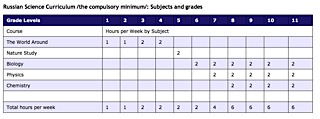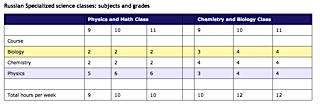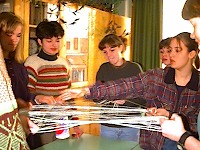Author: Sergei Tolstikov is a graduate teacher of EFL from Moscow, Russia. He has taught English at several Moscow high schools and colleges and is currently doing postgraduate research work at the Russian Academy of Education, and is an editor of an educational journal. An active participant of the Global Thinking Project for more than 10 years, he has worked with educators from several nations.
The
legislative basis of the Russian education system is organized on three levels:
federal, ethnic-regional and institutional. Strategic decisions and state
requirements are formulated at the federal and regional levels, but they find
their specific implementation at the institutional (school) level.
The
Russian education system organization is 4-5-2 (primary school, basic
school, senior school). The basic school curriculum consists of three
components: the federal, regional and the school. The federal component is
invariable and determines the compulsory minimum of educational program
content, the maximum amount of teaching periods for students, and the required
student achievement. The regional and school components give schools and
regions significant autonomy in curriculum content decisions, allowing schools
to add extra study hours for in-depth study of different subjects of their
choice, providing they meet the state requirement. For science curriculum charts for Russia please see The Art of Teaching Science Companion site.
Junior
Level Science
The
Russian science curriculum begins with a two-year experience called The World
Around in classes 1 through 4. The
focus of this experience is the exploration of the natural environment,
including gardens, parks, the countryside, changing seasons, and caring for
pets and indoor plants.
This
is followed by Nature Study in class 5.
Nature study involves the students in developing skills in observation,
inquisitiveness, and the love of nature.
The aims of the nature study include:
• Observing the weather, plants, behavior
of wild creatures and consequences for human health and agriculture.
• Focus on natural surroundings in the
Russian Federation, the human body, health and fitness and the concern for the
health of the people.
• Development of a holistic picture of the
natural world.
•
Emphasize the processes of science including observing natural objects,
comparing and contrasting, deduction, and generalizing.
The
content of nature study also includes Earth and other bodies, air and the water
cycle, conservation, rocks and soil, living organisms and their environment,
effect of human activity on the living world, and ecology.

The
Russian science curriculum from classes 6-11 is described as a spiral curriculum. In the curriculum, each science is
taught over a period of several years.
For example, in class 6, students begin their study of biology, which
continues for the next five years.
Then in each of the next two years students study first physics and then
chemistry and continue studying these subjects each year.
The
biology curriculum in class 6 is botany, and students meet for two periods of
instruction per week. Zoology is
introduced in class 7 and continues into class 8. Human anatomy and physiology are taught in class 9, and
general biology is offered in classes 10 and 11.
The
content of physics in class 7 includes physics phenomena, the structure of
matter, interaction of bodies, pressure, work, power and energy. In class 8 students study thermal,
electrical, electro-magnetic and light phenomena. In class 9 students study
kinematics, conservation laws, and waves.
In class 10 they study molecular physics, and electrodynamics, followed
in class 11 with a continuation of electrodynamics, as well as electromagnetic
waves, and quantum physics. As a part of the physics curriculum, in the last
year of school, students also take a course in astronomy, which introduces a
contemporary view of the universe, focusing on the practical use of astronomy.
The
chemistry curriculum begins in class 8.
The chemistry curriculum is focused on exploring two basic systems of
knowledge, namely, substances and processes. The content in classes 8 and 9 is the study of inorganic
chemistry, while in classes 10 and 11 the focus is on organic chemistry.

There are also an increasing number of specialized secondary schools,
lyceums and gymnasiums in Russia, where a variety of elective subjects are
taught and students can acquire a thorough knowledge in some field of study.
Sometimes specialized classes with an intensive study of certain subjects, such
as physics and mathematics, biology and chemistry are organized inside the
general secondary school.


